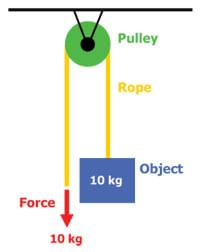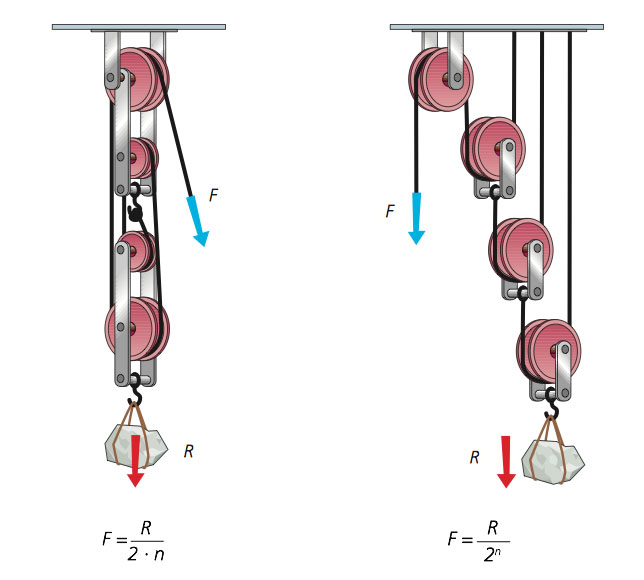2. LINEAR TRANSMISSION OF MOTION
Linear transmission mechanisms, such as pulleys, use linear motion input to produce linear motion output.
2.1. Levers.
A lever is a rigid bar that turns around a point called a fulcrum. Various forces may act on the lever at the same time.
Each force produces a specific torque, which is the foce multiplied by its distance from the fulcrum.
Torque= Force x Distance
When the forces acting on opposite ends of a lever are equal, we say the lever is in equilibrium. We can express this mathematically as the Law of the Lever.
F x d = R x r
F is the force or the effort that we use; d is its distance from the fulcrum; R is the resistance or load that we want to move; and r is its distance from the fulcrum.
Classes of levers
We can divide levers into classes according to the locations of the fulcrum, force and resistance.
Each class of leve has different uses:
- Class 2 levers increase the force that we apply.
- Class 3 levers increase the distance that the end of the lever moves.
- Class 1 levers can do both of those things.
Class 1
The fulcrum is between the force and the resistance.
The effect of the force applied is increased or decreased.
Class 2
The resistance is between the fulcrum and the force.
The effect of the force applied is always increased (d > r).
Class 3
The force is between the fulcrum and the resistance.
The effect of the force applied is always decreased (d < r).
Brake levers
Bicycle brakes decrease speed. We control them with levers on the handlebars. These levers pull on cables and the cables activate the brajes on the wheels.
A hand crank
We can use hand crank to apply force at a distance from the axis of the shaft.
F x d = R x r
F is the force that we apply; d is its distance from the axis of rotation.
R is the resistance in the shaft; and r is the radius of the shaft itself.
Uses: We use cranks to make rotation easier in various mechanisms, such as door handles and bicycle pedal systems.
The handlebars of a bicycle work like a crank. If we place our hands at the ends of the hanlebars, they are easier to turn. If we put our hands near the middle, it's more difficult to turn the handlebars.
2.2. Pulleys and compound pulley systems
In a system of pulleys, the equilibrium between the forces depends on the path that the rope follows.

Fixed pulley
The orces are equal because the rope moves the same distance on both sides. We can use gravity and our own weight to help us. It's easier to lift a weight by pulling down than by pulling up.
F = R
Force = Resistance
Movable pulley
The rope follows a double path around the pulleys. We need half the force to lift the same weight as with a fixed pulley. We must pull twice as much rope to lift an object to the same height.
F = R / 2
Force = Resistance / 2

←Fixed pulley
Movable pulley →
Compound pulley systems
A compound pulley system is a combination of fixed and movable pulleys. It is also called a block and tackle system. The more pulleys there are, the less force e need to lift the load. We can combine the pulleys in various ways:

No hay comentarios:
Publicar un comentario